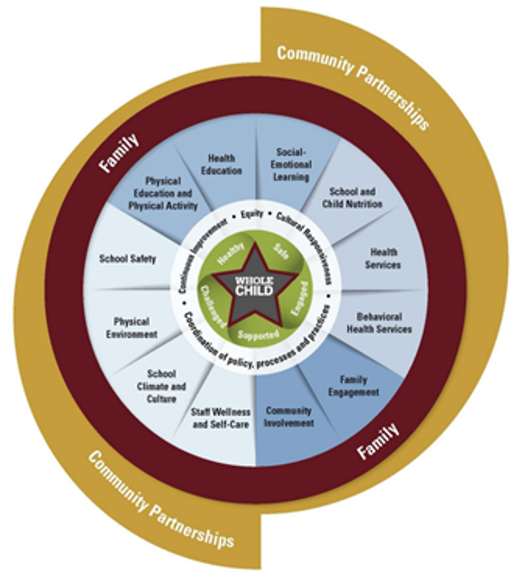This year, the ESC of Central Ohio was selected as a Whole Child Pilot site. This is an exciting opportunity for the ESC to build our capacity to support schools and districts in leveraging the powerful outcomes-driven model. With coaching and funding support from the Ohio Department of Education and ASCD, the ESC is working to embed the model within a local school district. We are learning about the power of the framework to ensure academic, behavioral, and attendance outcomes, deepening our understanding of the model and using an action planning protocol to align and move to an integrated and holistic approach to education. The opportunity will allow us to provide coaching and grow the work in other Central Ohio school districts working to embed the model.
What is the Whole Child Framework?
In essence, the Whole Child (WC) framework is a values-driven, comprehensive approach to education, aligning internal and external efforts to meet holistic needs of children, while leaning heavily on key partnerships with families and the community. The framework begins with five tenants which are commonly held beliefs reflecting optimally desired student conditions leading to success in life and learning. When students are healthy, feel safe, have strong supportive relationships, are challenged and experience success, and are engaged in learning that is relevant and meaningful, they are more likely to enjoy learning, develop positive social skills, and achieve greater academic success (Ohio Department of Education). The WC framework is not linear in nature (see infographic). It is interconnected with individual tenants and indicators informing and supporting the others. Interconnectedness is a powerful part of the WC framework because it creates space for us to think intentionally about the alignment of efforts.
 Healthy: Each student enters school healthy and learns about and practices a healthy lifestyle.
Healthy: Each student enters school healthy and learns about and practices a healthy lifestyle.Safe: Each student learns in an environment that is physically and emotionally safe for students and adults.
Engaged: Each student is actively engaged in learning and is connected to the school and broader community.
Supported: Each student has access to personalized learning and is supported by qualified, caring adults.
Challenged: Each student is challenged academically and prepared for success in college or further study and for employment and participation in a global environment
Each tenant aligns with 10 indicators that lead us to the desired conditions of each tenant. They are summarized as follows:
What does “Healthy” look like in our schools:
“Healthy” refers to the overall well-being (emotional, physical) for students and adults in the school. It includes the existence of a health curriculum and generally held value for a healthy lifestyle (emotional & physical). Space and time for physical movement exists and the facility is clean and in good condition. Also included is the emotional and physical health of school staff. With community partnerships who assist with food, medical, dental, eyes, etc. and food is nutritious and culturally appropriate.
What does “Safe” look like in schools:
Safety begins with a welcoming school environment and facility, where physical, emotional, and academic safety are recognized as important, and conditions are created. Students and staff feel a sense of belonging and PBIS (rules, routines, expectations) are embodied. Families too should be aware of and know the rules, routines, expectations of the school and SEL is integrated into curriculum and educator's model. And behavior interventions and policies are clear to everyone.
What does “Supported” look like in schools:
First, personalized learning, enrichment, and interventions are personalized, and data is collected to ensure student progress. Relationships are central to academic behavior, and attendance success and counselors, social workers, community partnerships are in place. Family partnerships are valued and are integrated, and energy is spent to build family capacity. Systems and staff have an attuned focus on vulnerable youth because of their unique needs.
What does it mean to be “Challenged”:
Curriculum choices are evidence-based and are engaging, challenging students to grow and master content. SEL competencies are integrated as part of the skills all kids must develop. Curriculums and instructional strategies make learning relevant, and learning is grounded in the world around us. An intentional focus is also placed on transition planning for all students.
What does it mean to be “Engaged”:
Curriculums are exciting and innovative, leveraging experiential learning, field trips and community partnerships. SEL instructional strategies are embedded, and content is relevant & related to the lived experiences of kids. This kind of curriculum supports self-directed learners.
How Do We Get There: The Roadmap to Implementing the Whole Child Framework
The WC framework requires us to first build foundational knowledge around the tenants and indicators. Then, by leveraging data tools provided through ASCD, teams can better identify strengths and areas of opportunity to grow the work. From there, the team will work to set planning goals and/or problem-solving protocols which can also be applied to the next set of Whole Child-aligned goals.
- Engage – Identify team (existing or new) and involve key stakeholders
- Design – Gather data, review results and plan goals based on current strengths and opportunities for growth
- Act – Implement your action plan (see action planning protocol outline below)
- Review and Modify – Reflect on process and outcomes and make targeted adjustments
The ESC is ready to support your Whole Child efforts. Through the use of perception and fidelity data, we can work together to explore current practices and set goals for areas where growth is needed. This isn’t more work - this is the work!
Contact Andrea Summers, Family & Community Partnership Liaison at [email protected] to learn more!